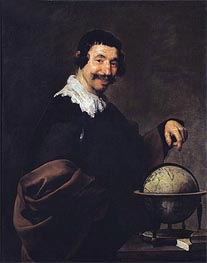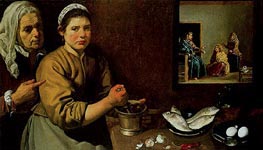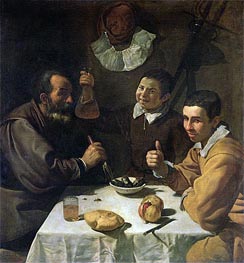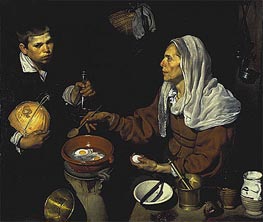The Waterseller of Seville, c.1620 Diego Rodriguez de Silva Velazquez (1599-1660)
Location: Wellington Museum London UKOriginal Size: 106 x 82 cm
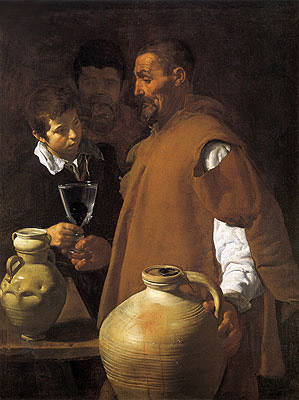

Recreating Velazquez: A Video Journey into Museum-Quality Reproductions by TOPofART
Video showcasing the process of hand-painting a Velazquez masterpiece with the utmost precision and care for detail.
Oil Painting Reproduction
If you want a different size than the offered
Description
Painted by European Аrtists with Academic Education
Museum Quality
+ 4 cm (1.6") Margins for Stretching
Creation Time: 8-9 Weeks
Creation Process
We create our paintings with museum quality and covering the highest academic standards. Once we get your order, it will be entirely hand-painted with oil on canvas. All the materials we use are the highest level, being totally artist graded painting materials and linen canvas.
We will add 1.6" (4 cm) additional blank canvas all over the painting for stretching.
High quality and detailing in every inch are time consuming. The reproduction of Diego Rodriguez de Silva Velazquez also needs time to dry in order to be completely ready for shipping, as this is crucial to not be damaged during transportation.
Based on the size, level of detail and complexity we need 8-9 weeks to complete the process.
In case the delivery date needs to be extended in time, or we are overloaded with requests, there will be an email sent to you sharing the new timelines of production and delivery.
TOPofART wants to remind you to keep patient, in order to get you the highest quality, being our mission to fulfill your expectations.
We not stretch and frame our oil paintings due to several reasons:
Painting reproduction is a high quality expensive product, which we cannot risk to damage by sending it being stretched.
Also, there are postal restrictions, regarding the size of the shipment.
Additionally, due to the dimensions of the stretched canvas, the shipment price may exceed the price of the product itself.
You can stretch and frame your painting in your local frame-shop.
Delivery
Once the painting The Waterseller of Seville is ready and dry, it will be shipped to your delivery address. The canvas will be rolled-up in a secure postal tube.
We offer free shipping as well as paid express transportation services.
After adding your artwork to the shopping cart, you will be able to check the delivery price using the Estimate Shipping and Tax tool.
Museum Quality
The paintings we create are only of museum quality. Our academy graduated artists will never allow a compromise in the quality and detail of the ordered painting. TOPofART do not work, and will never allow ourselves to work with low quality studios from the Far East. We are based in Europe, and quality is our highest priority.
Additional Information
The subject of the painting is the waterseller. This was a common trade for the lower classes in Velazquez's Seville. The jars and the topic of victuals recall the paintings called bodegon. The seller has two customers: a young boy, possibly painted from the same model as used for the boys in The Lunch and Old Woman Cooking Eggs, and a young man in the background shadows, (time has caused him to fade somewhat - he is clearer in the Uffizi version).
In the foreground sit the seller's gigantic pots of water, glistening with streams of running water. So large and rounded, they almost protrude out of the painting into the observer's space. The seller hands a freshly poured glass of water to the boy. In it sits a fig, a perfumer intended to make the water taste fresher - something still done in Seville today.
The still, calm scene - a typical quality of his genre scenes and, indeed, much of Velazquez's work - is remarkable for the depiction of the seller. His pensive face, battered by its direct exposure to sunlight, deeply scarred with the wrinkles of age, speaks of long years of experience. His short shaved hair and old plain clothes give him the appearance of a monk, or a saint, or an eccentric philosopher. He gazes into nothing, indicating deep thought, almost unaware of those around him. It is unnecessary for him to focus on his job, he is elsewhere: in a world inaccessible to both us and the boy.
In this picture, we see evidence of Velazquez's deep respect for the poor. He entitles the elderly seller to immense dignity, despite his lowly place in society. This attitude captures the essence of the bodegones - the idea that the simple, elemental nature of poverty is profound, effective in depicting higher subjects and morals such as biblical stories (e.g. Christ in the House of Martha and Mary).
Another proponent of this idea was Caravaggio, who significantly influenced this painting. Caravaggio was perhaps the most famous champion of the poor, going against the idealistic trends of Mannerism and the Renaissance and painting saints and divine beings as fallible cripples and prostitutes. Whilst not as aggressively provocative as Caravaggio, Velazquez does not by any means idealize his subject. Rather, he aims to represent it in a way that is precisely faithful to life. He captures the imperfections of the seller's pots, the saturations of dampness on their sides, the glistening of the light on the small drops of water and the glass, and the realistic expressions of the characters.
In the context of Velazquez's development as an artist, The Waterseller of Seville is a milestone. At this early point in his career he is already beginning to exhibit the technique of his later creations. His insight into the person of the seller is symptomatic of his insight into the subjects of his great portraits, and his precise rendition of the small details of reality demonstrate his famous understanding of human perception. These were both qualities which would distinguish him as one of the great European masters, and lead Manet to crown him "The Painter of Painters".
History of the painting
The painting has a long and colourful history. It was originally housed in the Royal Spanish Collection but stolen by Joseph Bonaparte at the time of the Napoleonic wars. The Duke of Wellington later won it - and 82 other paintings - back at the Battle of Vittoria. The King of Spain allowed him to keep them in return for beating the French. Wellington brought the painting back to England where it remains to this day, in Apsley House, his former home.
Other versions of The Waterseller of Seville
The Waterseller exists in three forms: the Wellington Museum version (above - the more famous and important of the three), the Uffizi version and the Walters version. The Uffizi version, painted as many as two to four years earlier, has a rather more burlesque feel with the seller wearing an ornate red hat. This may be more in line with his contemporaries' expectations due to the comical and devious image of the waterseller given in picaresque novels of the time.
The Walters version takes yet another angle on the waterseller. In this he appears almost despairing in his expression, perhaps to the extent of appearing farcical. The brilliant colours used are the most extreme of the three (with the pots taking on an altogether more shiny appearance). However, as in the Uffizi version, the characters lack the depth of personality present in the Wellington version.
